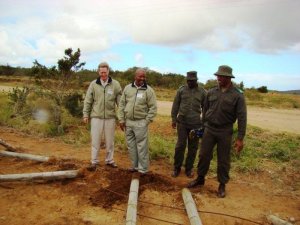NMBT applauds fence felling as Addo elephants return ‘home’

The elephant population of the Addo National Elephant Park might be a bit confused when they approach an area well-known for having a 4km stretch of fence blocking their path – and find it gone.
Last week Thursday (19 AUG), officials from Mandela Bay Tourism (NMBT), SANParks, rangers, volunteers, employees and members of the media converged at the fence and promptly begun a fence-cutting ceremony which would see an area of Addo National Elephant Park extended by 12 000ha to 24 000ha.
This would give the burgeoning elephant population additional roaming and grazing land, officials said.
“They say an elephant never forgets, and I think today will be one of those unforgettable moments for both them and us,” said NMBT marketing manager Titus Chuene, of the historic moment, where the elephants would be free return to their “ancestral land”.
In the 1920s a small herd of 11 elephant took refuge in the dense Oilphantsplaat thicket from government-endorsed hunts aimed at protecting the nascent farming industry. It is from this original group that the 550 strong herd that now dominates the Park grew, after the 11 elephants were incorporated into the Park in 1931.
“Now we can really say Mayibuye Ndlovu, or let the elephant return,” said SANParks executive manager Paul Daphne, who pointed to Addo as a prime example of the integration of conservation, tourism, commercial development and stakeholder engagement.
The dropping of the fence will effectively merge the two areas stretching from the Addo Main Camp down to the Park’s Camp Matyholweni rest camp near Colchester on the Algoa Bay coastline. Elephants, lion, hyena and other species will be able to move gradually across to the Colchester area of the Park. Buffalo, zebra and antelope species have already been introduced to the area.
“Addo is one of Nelson Mandela Bay’s biggest tourism drawcards, we are ecstatic that they are making headway on their expansion plans, and that their elephant population wins in the process by getting a little more breathing space,” added Chuene.
Environmental journalist Guy Rogers said it was quite interesting that the original 11 elephants had been lured from the thicket and into the Park in 1931 by oranges they were almost killed to protect. “Now, 79-years later, their descendants would follow the same path in the opposite direction, lured into the formerly inaccessible area by one of their favourite treats, the prickly pear. They will be treating themselves and also in the process do the environment a favour by controlling an invader species, prickly pear,” said Rogers.





















 Please wait!
Please wait!